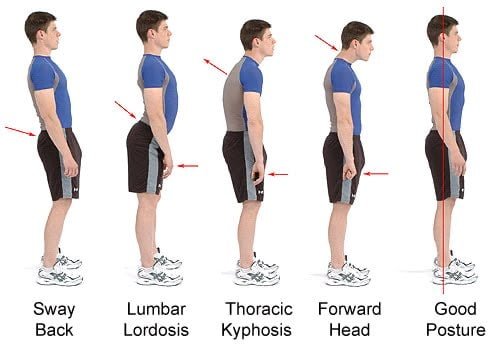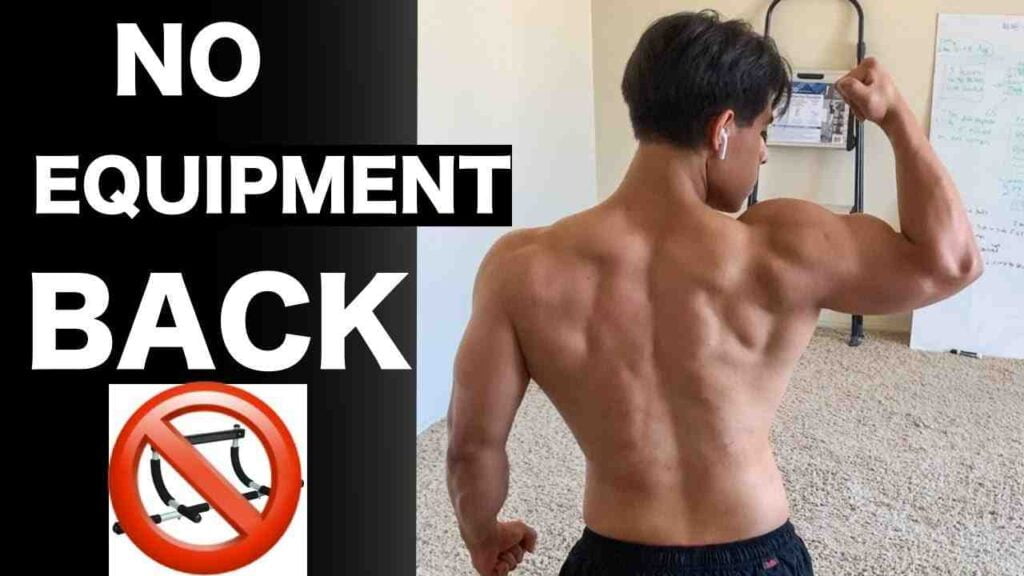Introduction
Are you looking for an Effective Back Workout with Dumbbells at Home? Look no further! In this article, we’ll guide you through an effective back workout using dumbbells in the comfort of your own home. Whether you’re a beginner or an experienced fitness enthusiast, these exercises will help you target and tone your back muscles for improved posture, strength, and overall fitness. So grab your dumbbells and let’s get started!
Back strength is crucial for overall fitness and functionality. A well-developed back not only improves posture but also supports other muscle groups during various physical activities. Incorporating dumbbells into your back workout routine at home can provide several benefits and help you achieve your fitness goals effectively.
Importance of back strength
Having a strong back is essential for maintaining good posture, preventing injuries, and supporting everyday movements. The back muscles, including the latissimus dorsi (lats), rhomboids, trapezius, and erector spinae, play a vital role in stabilizing the spine, supporting the upper body, and facilitating proper movement mechanics. A strong back can also enhance athletic performance and reduce the risk of back pain or discomfort.
Benefits of using dumbbells
Incorporating dumbbells into your back workout routine offers numerous advantages:
a. Versatility: Dumbbells provide a wide range of exercise options, allowing you to target specific back muscles from different angles and positions.
b. Balanced muscle development: Dumbbells require stabilizer muscles to engage, promoting balanced muscle development and addressing any strength imbalances.
c. Convenience: Dumbbells are compact and can be easily used at home, eliminating the need for expensive equipment or gym memberships.
d. Progressive overload: Dumbbells allow for progressive overload by increasing the weight incrementally, stimulating muscle growth and strength gains over time.
Safety precautions
While performing back exercises with dumbbells at home, it is crucial to prioritize safety to prevent injuries. Here are some important safety precautions to keep in mind:
a. Proper form and technique: Ensure you perform each exercise with the correct form to effectively target the back muscles and minimize the risk of strain or injury. Focus on maintaining a neutral spine, engaging the core, and avoiding excessive momentum.
b. Start with lighter weights: If you’re a beginner or new to back exercises, start with lighter dumbbells to establish the proper form and gradually increase the weight as you become more comfortable and confident.
c. Warm-up and cool-down: Prioritize a dynamic warm-up to prepare your muscles for exercise and a proper cool-down with stretching to promote flexibility and recovery.
d. Listen to your body: Pay attention to any discomfort, pain, or unusual sensations during the workout. If something feels off, adjust your technique or decrease the weight. Consult a healthcare professional if necessary.
By understanding the importance of back strength, harnessing the benefits of dumbbells, and following safety precautions, you can create an effective and safe back workout routine at home. Remember to always listen to your body and progress at a pace that suits your fitness level.
Warm-up Exercises
To prepare your muscles and prevent injuries, it’s essential to perform warm-up exercises before starting your back workout with dumbbells at home. Warm-up exercises increase blood flow to the muscles, improve flexibility, and enhance overall performance. Here are some effective warm-up exercises you can incorporate:
- Arm Circles: Stand tall with your feet shoulder-width apart. Extend your arms out to the sides parallel to the floor. Begin making small circles with your arms, gradually increasing the size of the circles. After a few seconds, reverse the direction. This exercise helps warm up the shoulder joints and muscles.
- Shoulder Rolls: Stand with your feet shoulder-width apart and relax your arms by your sides. Roll your shoulders forward in a circular motion for 10-15 seconds. Then, reverse the direction and roll them backward. This exercise helps loosen up the shoulder muscles and improve mobility.
- Cat-Cow Stretch: Get down on all fours with your hands directly under your shoulders and knees under your hips. Begin by arching your back upward like a stretching cat, and then lower your belly toward the floor, lifting your head and chest like a cow. Repeat this motion for 10-12 repetitions. The cat-cow stretch helps mobilize and warm up the entire spine.
- Side Bends: Stand with your feet shoulder-width apart and hold a dumbbell in one hand. Place your other hand on your hip. Slowly lean to the side, sliding the dumbbell along your thigh. Return to the starting position and repeat on the other side. Perform 10-12 repetitions on each side. Side bends warm up the muscles on the sides of your torso.
- Arm Swings: Stand with your feet shoulder-width apart. Extend your arms straight out to the sides, parallel to the floor. Begin swinging your arms forward and backward in a controlled manner. Gradually increase the speed and range of motion. Perform this exercise for 30 seconds to 1 minute. Arm swings increase blood flow and warm up the muscles of the upper back and shoulders.
Remember to perform each warm-up exercise smoothly and avoid any jerking or bouncing movements. Aim to spend 5-10 minutes on warm-up exercises to adequately prepare your back muscles and prevent potential injuries during your dumbbell back workout at home.
By incorporating these warm-up exercises into your routine, you’ll help prepare your muscles, increase flexibility, and optimize your performance for a productive back workout with dumbbells at home.
Dumbbell Exercises for Upper Back
When it comes to targeting your upper back muscles with dumbbells at home, there are several effective exercises you can incorporate into your routine. These exercises will help strengthen and develop muscles such as the rhomboids, traps, and rear deltoids. Remember to start with a weight that challenges you but allows you to maintain proper form. Here are three key exercises to include:
Bent-Over Rows
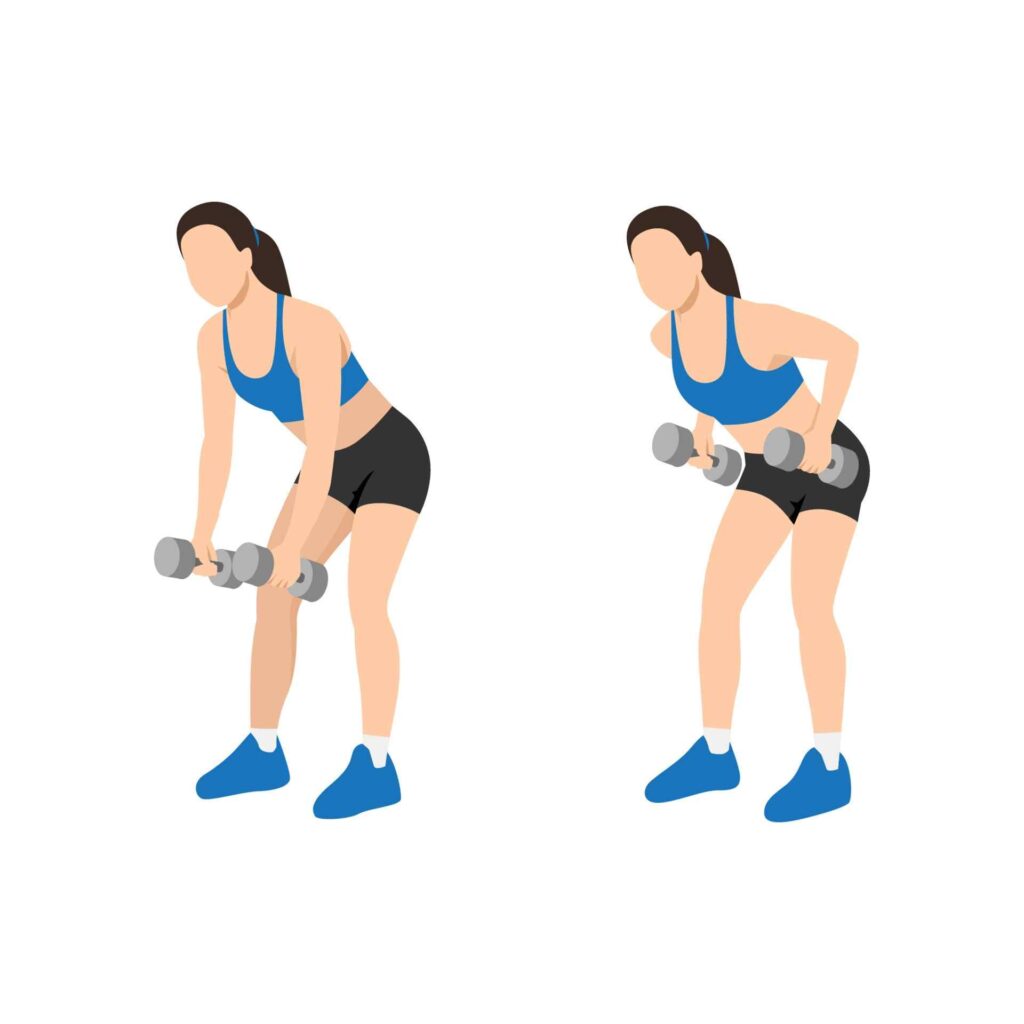
Bent-over rows are a classic compound exercise that primarily targets the muscles in your back. By bending at the waist and pulling a weighted barbell or dumbbell towards your chest, you engage your lats, rhomboids, and rear deltoids, promoting strength and stability in your upper body.
- Begin by standing with your feet shoulder-width apart, knees slightly bent.
- Hold a dumbbell in each hand, palms facing your body, and let your arms hang naturally in front of you.
- Hinge forward at the hips, keeping your back straight and core engaged. Your upper body should be almost parallel to the floor.
- From this position, squeeze your shoulder blades together and lift the dumbbells towards your chest, keeping your elbows close to your body.
- Pause for a moment at the top, then slowly lower the dumbbells back to the starting position.
- Aim for 3 sets of 10-12 repetitions.
Renegade Rows
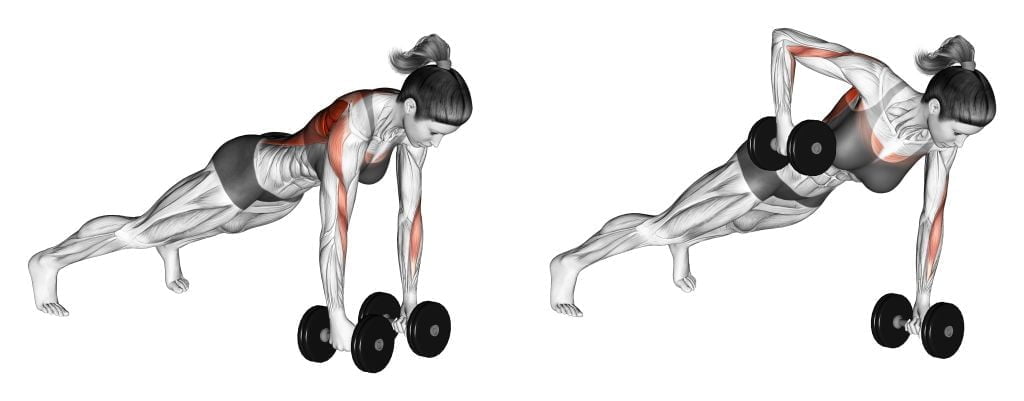
Renegade rows are a challenging and dynamic exercise that combines elements of a plank and a row. By assuming a plank position with your hands on dumbbells and alternating rows while stabilizing your core, you not only work your back muscles but also engage your abs, shoulders, and arms, enhancing overall upper body strength and coordination.
- Begin in a push-up position with a dumbbell in each hand, wrists aligned with your shoulders.
- Engage your core and keep your body in a straight line from head to heels.
- Slowly lift one dumbbell off the ground, pulling your elbow up towards the ceiling while keeping your body stable.
- Lower the dumbbell back to the ground and repeat the movement on the other side.
- Alternate sides for a total of 10-12 repetitions (5-6 per side).
- Aim for 3 sets.
Reverse Flyes
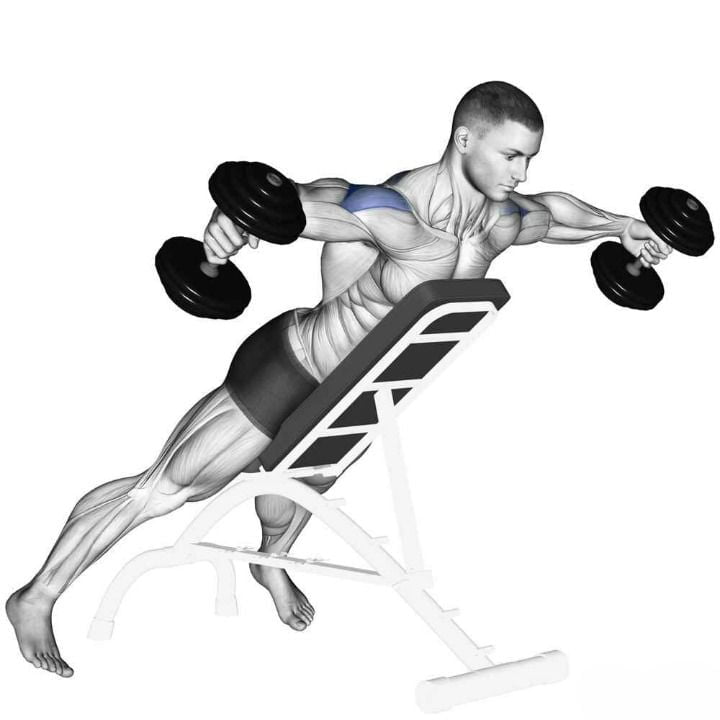
Reverse flyes target the muscles of your upper back, particularly the rear deltoids and rhomboids. By standing or lying face down and lifting weights out to the sides, you promote better posture, balance out your shoulder muscles, and improve overall shoulder mobility and stability. Reverse flyes are a great exercise for developing a strong and defined upper back.
- Start by standing with your feet shoulder-width apart, knees slightly bent.
- Hold a dumbbell in each hand, palms facing each other, and slightly bend your elbows.
- Hinge forward at the hips, maintaining a neutral spine.
- Keeping your core engaged, raise your arms out to the sides until they are parallel to the ground, squeezing your shoulder blades together.
- Pause for a moment at the top, then slowly lower the dumbbells back to the starting position.
- Aim for 3 sets of 12-15 repetitions.
Incorporating these exercises into your upper back workout routine will target different muscles and promote balanced development. Remember to focus on proper form, control your movements, and gradually increase your weight as you become stronger. With consistency and dedication, you’ll see improvements in your upper back strength and overall physique through these dumbbell exercises at home.
Dumbbell Exercises for Lower Back
To target and strengthen your lower back muscles using dumbbells at home, you can incorporate two effective exercises: Dumbbell Deadlifts and Romanian Deadlifts.
Dumbbell Deadlifts

Dumbbell Deadlifts primarily target your lower back, hamstrings, glutes, and also engage your core muscles.
- Stand with your feet hip-width apart, holding a dumbbell in each hand, palms facing your thighs.
- Keep your back straight, core engaged, and knees slightly bent.
- Lower the dumbbells towards the floor by hinging at your hips while maintaining a neutral spine.
- Keep the dumbbells close to your legs as you lower them.
- Once you feel a stretch in your hamstrings, push through your heels, and lift your body back up to the starting position.
- Squeeze your glutes at the top of the movement.
- Repeat for the desired number of repetitions.
Romanian Deadlifts
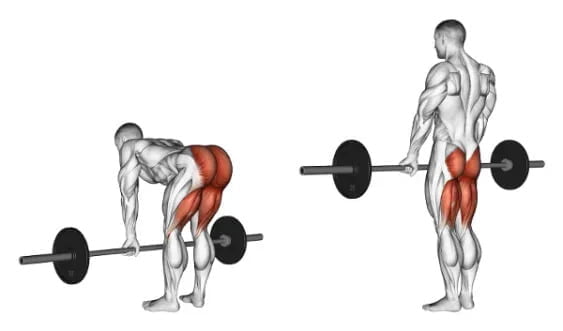
Romanian Deadlifts primarily target your lower back, hamstrings, and glutes, helping to develop strength and stability in those areas.
- Stand with your feet hip-width apart, holding a dumbbell in each hand, palms facing your body.
- Maintain a slight bend in your knees, keep your back straight, and engage your core.
- Lower the dumbbells towards the floor by hinging at your hips.
- As you lower the dumbbells, keep them close to your legs, and feel the stretch in your hamstrings.
- Once you reach a comfortable stretch, reverse the movement by squeezing your glutes and hamstrings to lift your body back up.
- Maintain control throughout the exercise, keeping your back straight and avoiding any excessive rounding or arching.
- Repeat for the desired number of repetitions.
Remember, when performing any exercise that targets the lower back, it’s essential to maintain proper form, engage your core muscles for stability, and use a weight that challenges you without compromising your technique. Start with lighter dumbbells and gradually increase the weight as your strength improves.
Incorporating these exercises into your back workout routine with dumbbells at home will help you strengthen and develop your lower back muscles, contributing to better posture, spinal stability, and overall strength.
Dumbbell Exercises for Overall Back Development
When it comes to overall back development with dumbbells at home, there are several effective exercises you can incorporate into your workout routine. These exercises target various muscles in your back, helping you build strength, stability, and definition. Here are three essential dumbbell exercises for overall back development:
One-Arm Dumbbell Rows
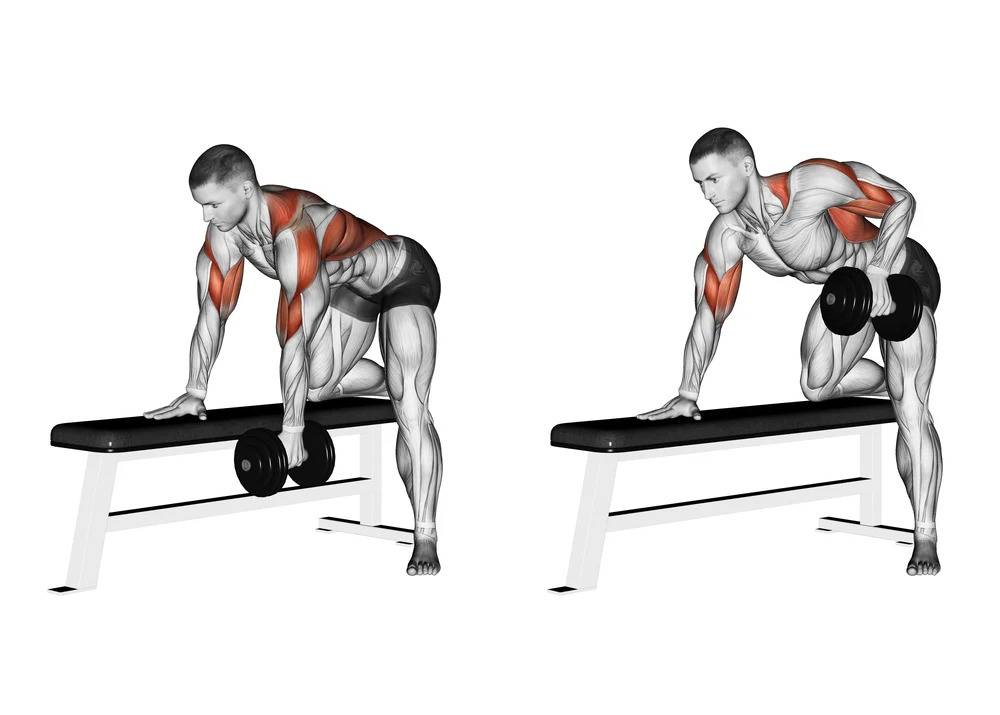
One-arm dumbbell rows are a powerful exercise that targets the muscles of the back, helping to strengthen and sculpt the lats, rhomboids, and rear deltoids for improved posture and overall upper body strength.
- Begin by placing a dumbbell on the floor next to a bench or sturdy platform.
- Position yourself with your right knee and right hand on the bench, keeping your back parallel to the ground.
- With your left hand, pick up the dumbbell and let it hang down at arm’s length, palm facing your torso.
- Pull the dumbbell up towards your chest by retracting your shoulder blade and bending your elbow.
- Pause briefly at the top and squeeze your back muscles.
- Lower the dumbbell back down in a controlled manner and repeat for the desired number of repetitions.
- Switch sides and perform the exercise with your left arm.
- Focus on maintaining proper form and engaging your back muscles throughout the movement.
Pull-Overs
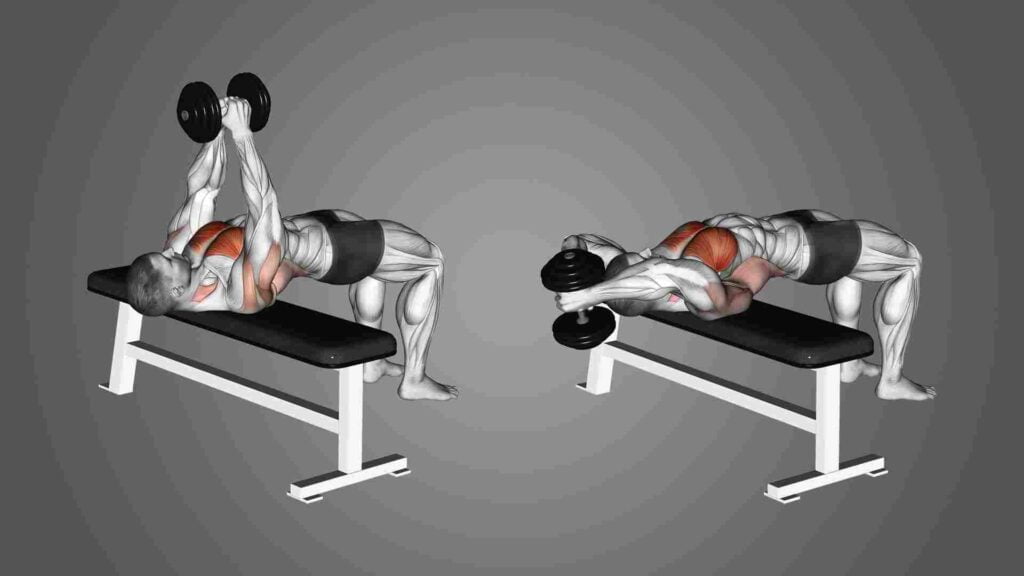
Pull-overs are versatile exercise that primarily engages the muscles of the chest, back, and shoulders. By utilizing a dumbbell or barbell, pull-overs promote upper body stability, enhance shoulder mobility, and contribute to an expanded chest and broader back.
- Lie flat on a bench with your head and upper back supported, holding a dumbbell with both hands extended above your chest.
- Keep your arms slightly bent and maintain a firm grip on the dumbbell.
- Slowly lower the dumbbell back over your head, maintaining control and feeling a stretch in your lats and chest.
- Once you reach a comfortable stretch, bring the dumbbell back to the starting position by engaging your back muscles.
- Exhale as you pull the dumbbell back up and squeeze your back muscles at the top.
- Repeat for the desired number of repetitions, focusing on the mind-muscle connection with your back.
Superman Dumbbell Pulls
Superman dumbbell pulls are a dynamic exercise that effectively engages the muscles of the upper and lower back, as well as the glutes and hamstrings. By mimicking the iconic “Superman” flying pose, this exercise helps improve spinal extension and overall posterior chain strength.
- Lie face down on an exercise mat or the floor, holding a dumbbell in each hand, palms facing down.
- Extend your arms forward and keep your legs straight.
- Simultaneously lift your arms, chest, and legs off the ground as if you’re flying like Superman.
- Squeeze your back muscles at the top of the movement and hold for a brief moment.
- Lower your arms, chest, and legs back down to the starting position in a controlled manner.
- Repeat for the desired number of repetitions, focusing on engaging your back muscles throughout the exercise.
Remember, proper form, controlled movements, and mind-muscle connection are crucial for optimal results. Start with a weight that challenges you but allows you to maintain good form. Gradually increase the weight as your strength improves. Incorporate these exercises into your back workout routine with dumbbells at home for overall back development.
Tips for Success
When it comes to achieving success in your back workout with dumbbells at home, there are several key tips to keep in mind:
Proper Form and Technique
Maintaining proper form and technique is crucial for maximizing the effectiveness of your exercises and minimizing the risk of injury. Here are some guidelines:
- Keep your back straight and engage your core muscles.
- Maintain a controlled and stable movement throughout each exercise.
- Avoid excessive swinging or using momentum to lift weights.
- Focus on squeezing your back muscles during the contraction phase of each exercise.
- Start with lighter weights if needed, and gradually increase as you become more comfortable with the movements.
Progression and Increasing Weight
To continue challenging your back muscles and promoting growth, it’s important to progressively increase the weight you use. Here’s how you can achieve progression:
- Begin with a weight that allows you to complete the desired number of repetitions with proper form.
- Once you can easily perform the prescribed number of reps, gradually increase the weight by small increments (e.g., 2.5-5 pounds).
- Aim to reach muscle fatigue within the target rep range for each exercise.
- Track your progress by keeping a workout log or using a fitness app to monitor the weights you use and the number of repetitions achieved.
Rest and Recovery
Allowing sufficient rest and recovery time is vital for muscle growth and preventing overuse injuries. Consider the following:
- Schedule at least one or two days of rest between back workouts to give your muscles time to repair and rebuild.
- Get an adequate amount of sleep each night (7-9 hours) to support muscle recovery.
- Consider incorporating active recovery activities, such as light stretching or low-intensity cardio, on rest days.
- Listen to your body. If you experience excessive soreness or fatigue, take additional rest days or modify the intensity of your workouts accordingly.
Effective Posture Improving Back Exercises
By prioritizing proper form and technique, gradually increasing the weight you use, and allowing ample rest and recovery, you’ll optimize your chances of success in your back workout with dumbbells at home. Remember to be patient and consistent in your training to see long-term progress.
FAQs
Q1: Can I effectively work my back muscles at home with just dumbbells?
Ans: Absolutely! Dumbbells are versatile and effective tools for targeting your back muscles at home. With a wide range of exercises such as bent-over rows, renegade rows, and dumbbell deadlifts, you can effectively engage your back muscles and promote strength and development.
Q2: How many times a week should I perform a back workout with dumbbells at home?
Ans: It’s generally recommended to train your back muscles 2-3 times per week for optimal results. This frequency allows for adequate recovery between sessions while providing enough stimulus to promote muscle growth. Remember to listen to your body and adjust the frequency based on your individual needs and recovery ability.
Q3: How do I know if I’m using the correct form during back exercises with dumbbells?
Ans: Using proper form is crucial for maximizing the benefits of your back workout and preventing injuries. Here are some tips:
- Educate yourself: Watch instructional videos or seek guidance from fitness professionals to understand the correct form for each exercise.
- Focus on alignment: Keep your back straight, shoulders down and back, and engage your core muscles.
- Start with lighter weights: Begin with weights that allow you to perform the exercise with proper form. Gradually increase the weight as you become more comfortable and confident.
- Use mirrors or recording: Utilize mirrors or record your workouts to observe your form and make necessary adjustments.
Q4: Can I build a strong and well-defined back with dumbbell exercises alone?
Ans: Yes, you can definitely build a strong and well-defined back with dumbbell exercises. Dumbbells offer a wide range of exercises that target various muscles in your back, including the upper, middle, and lower back. By consistently challenging your muscles with progressive overload (increasing weights), proper nutrition, and adequate rest, you can achieve significant back strength and definition.
Q5: How long does it take to see results from a back workout with dumbbells at home?
Ans: The timeline for seeing results can vary depending on various factors such as your current fitness level, consistency of training, nutrition, and genetics. With regular and dedicated training, you can typically start noticing improvements in your back strength and muscle tone within a few weeks. However, significant transformations may take several months of consistent effort.
Remember, individual results may vary, so focus on enjoying the process and celebrating small milestones along the way.
Conclusion
Incorporating a back workout with dumbbells into your home fitness routine can be an effective and convenient way to strengthen and develop your back muscles. By following proper form and technique, gradually increasing the weight you use, and allowing adequate rest and recovery, you can achieve remarkable results.
The versatility of dumbbells allows you to target specific muscles in your upper, middle, and lower back, promoting overall back strength and stability. From bent-over rows and renegade rows to dumbbell deadlifts and pull-overs, there are numerous exercises you can perform at home with just a set of dumbbells.
Consistency and patience are key to success. Aim to train your back muscles 2-3 times a week, focusing on quality repetitions rather than rushing through the exercises. As you progress, gradually increase the weight you use to challenge your muscles and promote growth.
While performing your back workout, always prioritize proper form and technique to minimize the risk of injury and maximize the effectiveness of each exercise. Remember to listen to your body, providing it with adequate rest and recovery time to optimize your results.
Keep in mind that results may vary from person to person, and it may take time to see significant changes in your back strength and muscle definition. Embrace the journey and celebrate your progress along the way.
By following the guidance and incorporating the tips provided in this article, you have the tools to embark on a rewarding back workout journey with dumbbells at home. Strengthening your back muscles not only enhances your physical appearance but also improves your posture, stability, and overall upper body strength. Get started today and enjoy the benefits of a strong and well-defined back!

Good day, and welcome to Fitthour. My name is Shubham Vijay, and I am a certified personal trainer and nutrition coach with 6 years of experience in the fitness industry. At Fitthour, we specialize in types of training, such as strength training, cardio, or HIIT, and our mission is to help clients achieve their fitness goals and improve their overall health.

